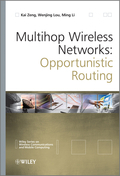
This book provides an introduction to opportunistic routing an emerging technology designed to improve the packet forwarding reliability, network capacity and energy efficiency of multihop wireless networks This book presents a comprehensive background to the technological challenges lying behind opportunisticrouting. The authors cover many fundamental research issues for this new concept, including the basic principles, performance limit and performance improvement of opportunistic routing compared to traditional routing, energy efficiency and distributed opportunistic routing protocol design, geographic opportunistic routing, opportunistic broadcasting, and security issues associated with opportunistic routing, etc. Furthermore, the authors discuss technologies suchas multi-rate, multi-channel, multi-radio wireless communications, energy detection, channel measurement, etc. The book brings together all the new resultson this topic in a systematic, coherent and unified presentation and providesa much needed comprehensive introduction to this topic. Key Features: Addresses opportunistic routing, an emerging technology designed to improve the packet forwarding reliability, network capacity and energy efficiency of multihop wireless networks Discusses the technological challenges lying behind this new technology, and covers a wide range of practical implementation issues Explores many fundamental research issues for this new concept, including the basic principles of opportunistic routing, performance limits and performance improvement, and compares them to traditional routing (e.g. energy efficiency and distributed opportunistic routing protocol design, broadcasting, and security issues) Covers technologies such as multi-rate, multi-channel, multi-radio wireless communications, energy detection, channel measurement, etc. This book provides an invaluable reference for researchers working in the field of wireless networks and wireless communications, and Wireless professionals. Graduate students will also find this book of interest. INDICE: About the Series Editors Preface List of Abbreviations 1 Introduction 1.1 Multihop wireless networks 1.2 Routing challenges in MWNs 1.3 Routing techniques in MWNs 1.4 Related work 1.5 Book contribution 1.6 System model andassumptions References 2 Taxonomy of opportunistic routing: principles and behaviors 2.1 EPA generalization 2.2 Principles of local behavior of GOR 2.3 Least cost opportunistic routing 2.4 Conclusions References 3 Energy efficiency of geographic opportunistic routing 3.1 EGOR problem formulation 3.2 Efficient localized node-selection algorithms 3.3 Energy-efficient geographic opportunistic routing 3.4 Performance evaluation 3.5 Conclusion References 4 Capacity ofmultirate opportunistic routing 4.1 Computing throughput bound of OR 4.2 Impact of transmission rate and forwarding strategy on throughput 4.3 Rate and candidate selection schemes 4.4 Performance evaluation 4.5 Conclusion References 5 Multiradio multichannel opportunistic routing 5.1 Introduction 5.2 System model and opportunistic routing primer 5.3 Problem formulation 5.4 Forwarding priority scheduling 5.5 Performance evaluation 15.6 Conclusions and future work References 6 Medium access control for opportunistic routing - candidate coordination 6.1 Existing candidate coordination schemes 6.2 Design and analysis ofFSA 6.3 Simulation results and evaluation 6.4 Conclusions References 7 Integration of opportunistic routing and network coding 7.1 A brief review of MORE 7.2 Mobile content distribution in VANETs 7.3 Related works on mobile content distribution in VANETs 7.4 Background on symbol-level network coding 7.5 CodeOn: a cooperative popular content broadcast scheme for VANETs based on SLNC 7.6 CodePlay: a live multimedia streaming scheme for VANETs based on SLNC 7.7 ConclusionReferences 8 Multirate geographic opportunistic routing protocol design 8.1 System model 8.2 Impact of transmission rate and forwarding strategy on ORperformance 8.3 Opportunistic effective one-hop throughput (OEOT) 8.4 Heuristic candidate selection algorithm 8.5 Multirate link-quality measurement 8.6 Performance evaluation 8.7 Conclusion References 9 Opportunistic routing security 9.1 Attack on link quality measurement 9.2 Attacks on opportunistic coordination protocols 9.3 Resilience to packet-dropping attack 9.4 Conclusion References 10 Opportunistic broadcasts in vehicular networks 10.1 Related works on broadcasts in general MWNs 10.2 Related works on broadcasts in VANETs 10.3 Problem statement 10.4 Overview of OppCast 10.5 OppCast: main design 10.6 Parameteroptimization 10.7 Performance evaluation 10.8 Conclusion References 11 Conclusions and future research 11.1 Summary 11.2 Future research directions References Index
- ISBN: 978-0-470-66617-3
- Editorial: John Wiley & Sons
- Encuadernacion: Cartoné
- Páginas: 320
- Fecha Publicación: 17/06/2011
- Nº Volúmenes: 1
- Idioma: Inglés
